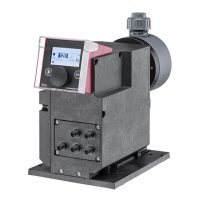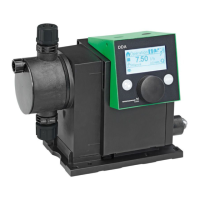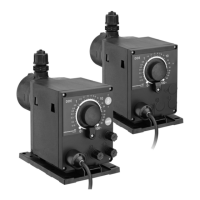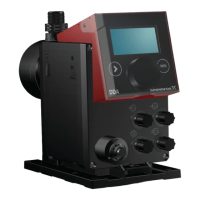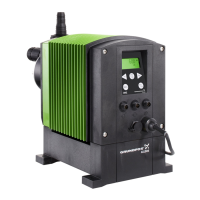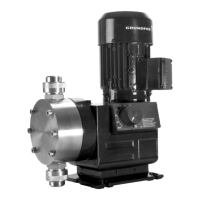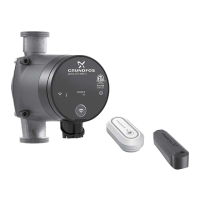
Do you have a question about the Grundfos SMART Digital XL DDA 200-4 and is the answer not in the manual?
| Model | DDA 200-4 |
|---|---|
| Flow Rate (max) | 200 l/h |
| Pressure (max) | 4 bar |
| Control | Digital |
| Turndown ratio | 1:3000 |
| Power Supply | 1 x 100-240 VAC, 50/60 Hz |
| Protection class | IP65 |
| Analog input | 0/4-20 mA |
| Max Head | 40 m |
| Frequency | 50/60 Hz |
| Type | Dosing pump |
| Operating temperature | 0°C to 45°C |
| Digital inputs | Pulse |
| Voltage | 100-240 V |
| Material | Stainless steel |
Explains hazard symbols, warnings, and tips for understanding the manual.
Defines the necessary qualifications and training for personnel handling the pump.
Crucial safety guidelines for users, including electrical safety precautions.
Procedures to ensure system safety during dosing pump malfunctions.
Precautions and safety measures when working with chemical dosing media.
Critical warnings regarding explosion risks from diaphragm leaks.
Details on the optional Diaphragm Leakage Detection (DLD) system.
Proper conditions for storage, unpacking, and transport of the pump.
Lists suitable media and typical application areas for the dosing pump.
Highlights prohibited uses and incorrect operating procedures.
Explanation of symbols on the pump and details on the nameplate.
Guide to understanding the pump's type designation and its components.
Visual representation of pump components with references to relevant sections.
Comprehensive specifications including flow rates, pressure, and electrical properties.
Specific technical data relevant for Clean-In-Place (CIP) applications.
Detailed dimensional drawings and measurements of the pump.
General instructions for assembling and correctly mounting the pump.
Essential guidelines and safety warnings for making hydraulic connections.
Safe procedures for connecting the pump to the power supply.
Diagrams and pin assignments for signal inputs and outputs.
Critical checks and preparations before the initial pump start.
Step-by-step instructions for starting the pump for the first time.
Guide to selecting and changing the display language on the pump interface.
Procedure for removing air from the pump system to ensure proper function.
When and how to calibrate the pump for accurate dosing volumes.
A practical step-by-step example of the pump calibration process.
Overview of the pump's display and physical control buttons.
Explanation of display indicators, icons, and operating states.
Instructions on how to navigate through the pump's menu system.
Description of different states the pump can be in and their visual indicators.
Information on the pump's energy-saving sleep mode function.
Comprehensive list and meaning of all display symbols.
Introduction to the primary navigation menus: Operation, Info, Alarm, Setup.
Information displayed within the main "Operation" menu.
Accessing date, counters, and product data via the "Info" menu.
Procedures for viewing, acknowledging, and managing alarms and warnings.
Accessing and modifying pump configuration settings via the "Setup" menu.
Overview of the various modes the pump can operate in.
Details on operating the pump in manual dosing mode.
Using external pulses to control dosing volume and frequency.
Dosing control based on external analog input signals.
Adjusting the mapping between analog input signals and dosing flow.
Dosing a set volume with each incoming pulse trigger.
Dosing a specific volume at regular, pre-set time intervals.
Programming complex weekly dosing schedules with multiple procedures.
Setting up and understanding analog feedback signals from the pump.
Using SlowMode to manage viscosity, degassing, or suction lift issues.
Preventing unintended dosing after a power interruption.
Using pressure sensing for accurate flow monitoring and error detection.
Monitoring discharge pressure and configuring pressure-related alarms.
Table detailing adjustable pressure limits for different pump models.
Procedure for calibrating the internal pressure sensor.
How the pump measures and displays the actual dosing flow rate.
Automatically adjusts stroke frequency to maintain target flow accuracy.
Automatic removal of air bubbles from the dosing head.
Function to detect diaphragm leaks in DDA-AR variants.
Setting up password protection to prevent unauthorized changes to settings.
Procedure for temporarily unlocking the pump's settings.
Steps to permanently disable the key lock feature.
Customizing display properties like units, contrast, and additional data.
Choosing between metric and US units for displayed measurements.
Configuring extra information to be shown on the pump display.
Setting the pump's internal clock and date for accurate logging.
Enabling and configuring pump communication via fieldbus systems.
Specifics on setting up and activating GENIbus communication.
Overview of compatible industrial communication interfaces (CIM modules).
Step-by-step guide to initiate communication with the pump via bus.
Procedure for assigning a unique address for bus communication.
How bus communication impacts pump operation and menu access.
Steps to disable pump communication via the bus interface.
Detection and management of errors occurring during bus communication.
Configuring external signals and relay outputs for pump control.
Assigning functions to the pump's two relay outputs.
Using external signals to stop the pump operation safely.
Connecting and interpreting signals from low-level and empty tank sensors.
Restoring default settings or saving/loading custom configurations.
Daily, weekly, and monthly checks for pump wear and condition.
Guidelines for cleaning the exterior surfaces of the pump.
Understanding when service is required based on runtime or time intervals.
Essential precautions and safety rules before undertaking service.
Exploded views of pump components to aid in service procedures.
Step-by-step guide for safely dismantling the dosing head assembly.
Instructions for correctly reassembling the dosing head after service.
Procedure for replacing the deaeration valve using special tools.
Steps for replacing the Diaphragm Leakage Detection sensor.
Instructions for safely replacing the pump's main power cable.
Detailed information on diaphragm leaks, causes, and explosion risks.
Specific disassembly procedures when a diaphragm leak is suspected.
Actions required if dosing liquid has entered the pump's internal housing.
Instructions for contacting Grundfos for pump repair services.
Overview of fault symbols, warnings, and alarms displayed by the pump.
Detailed list of pump faults, their causes, and recommended remedies.
Common faults that may occur without specific error messages.
Instructions for environmentally responsible disposal of the pump.

